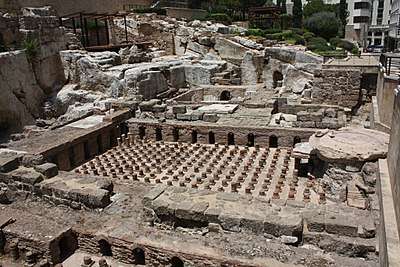Roman Baths, Beirut

Roman Berytus (Roman Baths) are located in the middle of downtown Beirut, Lebanon between Banks Street and Capuchin Street.[1] The remains of a Roman bath now surrounded by government buildings were found and conserved for posterity.
Overview
Roman Berytus Baths is an ancient Roman thermae or bath site inside the Roman city of Berytus. It was discovered in 1968-1969 and underwent major renovation in the mid-1990s.[2]
The archaeological ruin of one of the baths has been preserved and is occasionally used as a performance space, thus reflecting the ancient traditions of the site.[3] One of the Baths is used as an artistic performance and concert space. The modern site is also home to Mediterranean-style gardens[4] that contain a variety of medicinal plants once used in bathing balms.
The Roman bathhouse was a meeting place for all citizens. Roman Berytus had four major bath complexes (thermae). The bather moved from warm to hot baths, through rooms of varying temperatures. Located under the floor, the heating system (hypocaust) located under the floor allowed the air, warmed by wood fires in adjacent vaults, to circulate between pillars of terracotta disks that heated the marble floor; terracotta pipes in the walls allowed the air to rise up to the ceiling. Water from the boiler fed the marble-tiled pools in the hot room (caldarium), and a large stone basin (labrum) contained cool water for the bathers’ use. The bathing routine ended with a body massage of therapeutic oils. The high vaulted, spacious halls of the bathhouse also accommodated performances of jesters and musicians. Today, the location of the Roman Baths is occasionally used as a performance space, thus reflecting the ancient traditions of the site.
See also
References
- ↑ "Solidere".
- ↑ "Beirut.com".
- ↑ Linda Jones Hall, Roman Berytus: Beirut in Late Antiquity, Psychology Press, 2004
- ↑ "Solidere".
Bibliography
- Mouterde, René et Lauffray, Jean (1952) Beyrouth ville romaine, Publications de la Direction des Antiquités du Liban, Beyrouth.
- Lauffray, Jean (1977) « Beyrouth. Archéologie et Historie, époques gréco-romaines. I. Période hellénistique et Haut-Empire romain", Aufstieg und Niedergang der Romischen Welt. II.8 : 135-163, Wallter de Gruyter, Berlin.
- Beirut.com